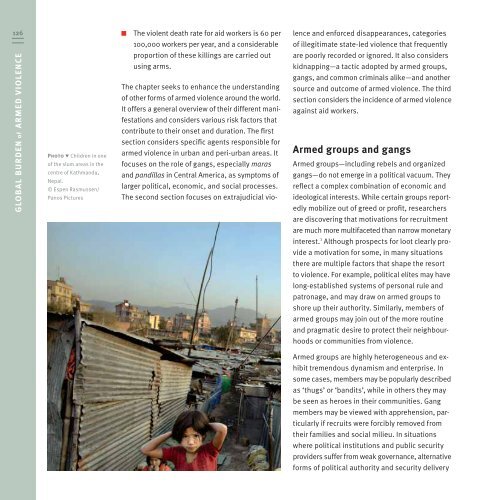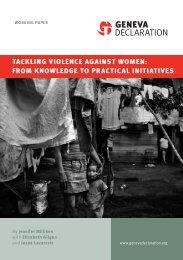Global Burden of Armed Violence - The Geneva Declaration on ...
Global Burden of Armed Violence - The Geneva Declaration on ...
Global Burden of Armed Violence - The Geneva Declaration on ...
You also want an ePaper? Increase the reach of your titles
YUMPU automatically turns print PDFs into web optimized ePapers that Google loves.
126 <str<strong>on</strong>g>The</str<strong>on</strong>g> violent death rate for aid workers is 60 per<br />
GLOBAL BURDEN <str<strong>on</strong>g>of</str<strong>on</strong>g> ARMED VIOLENCE<br />
Photo " Children in <strong>on</strong>e<br />
<str<strong>on</strong>g>of</str<strong>on</strong>g> the slum areas in the<br />
centre <str<strong>on</strong>g>of</str<strong>on</strong>g> Kathmandu,<br />
Nepal.<br />
© Espen Rasmussen/<br />
Panos Pictures<br />
100,000 workers per year, and a c<strong>on</strong>siderable<br />
proporti<strong>on</strong> <str<strong>on</strong>g>of</str<strong>on</strong>g> these killings are carried out<br />
using arms.<br />
<str<strong>on</strong>g>The</str<strong>on</strong>g> chapter seeks to enhance the understanding<br />
<str<strong>on</strong>g>of</str<strong>on</strong>g> other forms <str<strong>on</strong>g>of</str<strong>on</strong>g> armed violence around the world.<br />
It <str<strong>on</strong>g>of</str<strong>on</strong>g>fers a general overview <str<strong>on</strong>g>of</str<strong>on</strong>g> their different mani-<br />
festati<strong>on</strong>s and c<strong>on</strong>siders various risk factors that<br />
c<strong>on</strong>tribute to their <strong>on</strong>set and durati<strong>on</strong>. <str<strong>on</strong>g>The</str<strong>on</strong>g> first<br />
secti<strong>on</strong> c<strong>on</strong>siders specific agents resp<strong>on</strong>sible for<br />
armed violence in urban and peri-urban areas. It<br />
focuses <strong>on</strong> the role <str<strong>on</strong>g>of</str<strong>on</strong>g> gangs, especially maras<br />
and pandillas in Central America, as symptoms <str<strong>on</strong>g>of</str<strong>on</strong>g><br />
larger political, ec<strong>on</strong>omic, and social processes.<br />
<str<strong>on</strong>g>The</str<strong>on</strong>g> sec<strong>on</strong>d secti<strong>on</strong> focuses <strong>on</strong> extrajudicial vio-<br />
lence and enforced disappearances, categories<br />
<str<strong>on</strong>g>of</str<strong>on</strong>g> illegitimate state-led violence that frequently<br />
are poorly recorded or ignored. It also c<strong>on</strong>siders<br />
kidnapping—a tactic adopted by armed groups,<br />
gangs, and comm<strong>on</strong> criminals alike—and another<br />
source and outcome <str<strong>on</strong>g>of</str<strong>on</strong>g> armed violence. <str<strong>on</strong>g>The</str<strong>on</strong>g> third<br />
secti<strong>on</strong> c<strong>on</strong>siders the incidence <str<strong>on</strong>g>of</str<strong>on</strong>g> armed violence<br />
against aid workers.<br />
<str<strong>on</strong>g>Armed</str<strong>on</strong>g> groups and gangs<br />
<str<strong>on</strong>g>Armed</str<strong>on</strong>g> groups—including rebels and organized<br />
gangs—do not emerge in a political vacuum. <str<strong>on</strong>g>The</str<strong>on</strong>g>y<br />
reflect a complex combinati<strong>on</strong> <str<strong>on</strong>g>of</str<strong>on</strong>g> ec<strong>on</strong>omic and<br />
ideological interests. While certain groups report-<br />
edly mobilize out <str<strong>on</strong>g>of</str<strong>on</strong>g> greed or pr<str<strong>on</strong>g>of</str<strong>on</strong>g>it, researchers<br />
are discovering that motivati<strong>on</strong>s for recruitment<br />
are much more multifaceted than narrow m<strong>on</strong>etary<br />
interest. 1 Although prospects for loot clearly pro-<br />
vide a motivati<strong>on</strong> for some, in many situati<strong>on</strong>s<br />
there are multiple factors that shape the resort<br />
to violence. For example, political elites may have<br />
l<strong>on</strong>g-established systems <str<strong>on</strong>g>of</str<strong>on</strong>g> pers<strong>on</strong>al rule and<br />
patr<strong>on</strong>age, and may draw <strong>on</strong> armed groups to<br />
shore up their authority. Similarly, members <str<strong>on</strong>g>of</str<strong>on</strong>g><br />
armed groups may join out <str<strong>on</strong>g>of</str<strong>on</strong>g> the more routine<br />
and pragmatic desire to protect their neighbour-<br />
hoods or communities from violence.<br />
<str<strong>on</strong>g>Armed</str<strong>on</strong>g> groups are highly heterogeneous and ex-<br />
hibit tremendous dynamism and enterprise. In<br />
some cases, members may be popularly described<br />
as ‘thugs’ or ‘bandits’, while in others they may<br />
be seen as heroes in their communities. Gang<br />
members may be viewed with apprehensi<strong>on</strong>, par-<br />
ticularly if recruits were forcibly removed from<br />
their families and social milieu. In situati<strong>on</strong>s<br />
where political instituti<strong>on</strong>s and public security<br />
providers suffer from weak governance, alternative<br />
forms <str<strong>on</strong>g>of</str<strong>on</strong>g> political authority and security delivery









